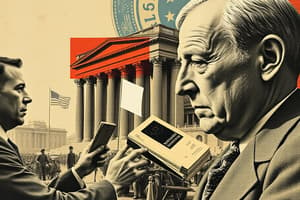Podcast
Questions and Answers
What is the effect on firms' demand for labor if the real wage rate is above the equilibrium level?
What is the effect on firms' demand for labor if the real wage rate is above the equilibrium level?
- Firms will balance their labor demand perfectly.
- Firms will demand less labor than is offered. (correct)
- Firms will not change their hiring practices.
- Firms will hire more employees than they need.
What results from the quick adjustment of the real wage rate in a free-market economy?
What results from the quick adjustment of the real wage rate in a free-market economy?
- The labor supply remains constant.
- An increase in aggregate demand.
- Involuntary unemployment decreases. (correct)
- Firms face less competition in hiring.
What is indicated when the labor demand curve shifts to the left due to a decrease in aggregate demand?
What is indicated when the labor demand curve shifts to the left due to a decrease in aggregate demand?
- A significant increase in labor costs for firms.
- A surplus of labor at the current wage rate. (correct)
- An increase in the equilibrium wage rate.
- A decrease in the number of workers willing to supply labor.
At what real wage rate is it stated there is no involuntary unemployment?
At what real wage rate is it stated there is no involuntary unemployment?
How does wage flexibility contribute to the labor market?
How does wage flexibility contribute to the labor market?
What is the primary reason sellers reduce prices when aggregate expenditure declines?
What is the primary reason sellers reduce prices when aggregate expenditure declines?
According to classical economics, what type of unemployment do workers who refuse to work at lower wages experience?
According to classical economics, what type of unemployment do workers who refuse to work at lower wages experience?
What did A.C. Pigou attribute as a major factor preventing full employment during the Great Depression?
What did A.C. Pigou attribute as a major factor preventing full employment during the Great Depression?
What is the Pigou effect as described in classical economic thought?
What is the Pigou effect as described in classical economic thought?
How do classical economists expect the labor market to adjust in response to a decline in demand for output?
How do classical economists expect the labor market to adjust in response to a decline in demand for output?
Flashcards
Classical Theory of Employment
Classical Theory of Employment
A decline in demand leads to lower prices, businesses reduce wages to maintain profits, restoring equilibrium at full employment.
Voluntary Unemployment
Voluntary Unemployment
Unemployed workers choose not to work at lower wages, assuming flexible wages ensure full employment.
Real Balance Effect
Real Balance Effect
Cutting wages lowers the price level, increasing labor demand to restore full employment.
Full Employment Equilibrium
Full Employment Equilibrium
Signup and view all the flashcards
Quantity Theory of Money
Quantity Theory of Money
Signup and view all the flashcards
Equation of Exchange
Equation of Exchange
Signup and view all the flashcards
Monetary Equilibrium
Monetary Equilibrium
Signup and view all the flashcards
Neutrality of Money
Neutrality of Money
Signup and view all the flashcards
Saving-Investment Equilibrium
Saving-Investment Equilibrium
Signup and view all the flashcards
Classical Model and Monetary Policy
Classical Model and Monetary Policy
Signup and view all the flashcards
Study Notes
Classical Theory of Employment
- According to classical economics, a decline in demand for goods leads to a decrease in prices, not production and employment.
- Businesses reduce factor prices, including wages, to maintain profitability.
- A decrease in demand for labor leads to lower wages, restoring equilibrium at full employment.
- Unemployed workers are considered voluntarily unemployed because they choose not to work at lower wages.
- Classical theory argues that involuntary unemployment is impossible in a free-market capitalist economy.
- A.C. Pigou, a neoclassical economist, advocated for wage cuts during the Great Depression to address widespread unemployment.
- Pigou argued that government interventions and trade unions artificially kept wages high, hindering economic recovery.
- Pigou's theory of the "real balance effect" suggests that a cut in wages lowers the price level and increases the demand for labor, leading to full employment.
- Wage flexibility, quick adjustment of wages, plays a crucial role in achieving full employment.
Self-Correction and Full Employment
- When aggregate demand decreases, the labor demand curve shifts to the left, resulting in an excess supply of labor.
- The short-run production function shows diminishing returns to labor.
- With full employment, total output (OYF) is distributed between wages and profits, representing the total income of the society.
- The economy reaches equilibrium with full employment when there is no excess supply or demand for labor due to flexible wages.
- Given the state of technology and the stock of capital, full employment of labor (NF) determines the potential GDP or full-employment output (YF).
- The potential GDP represents the maximum output achievable with existing resources and technology when the labor market is in equilibrium.
The Quantity Theory of Money and Monetary Equilibrium
- The Quantity Theory of Money states that the general price level is directly proportional to the money supply.
- The equation of exchange (MV = PY) relates the money supply (M), velocity of money (V), price level (P), and real GDP (Y).
- The Cambridge version of the Quantity Theory emphasizes the demand for money (Md) as a proportion (k) of national income (PY).
- Monetary equilibrium occurs when the supply of money (M) equals the demand for money (Md).
- In the classical model, money is neutral in its effect on real variables like output and employment.
- Changes in the money supply only affect nominal variables like prices and wages, not real variables.
Neutrality of Money and Saving-Investment Equilibrium
- Classical theory views money as a medium of exchange, demanded primarily for transaction purposes.
- Money is a neutral factor in the economy, impacting only the price level and not real variables like output and employment.
- The neutrality of money arises from the fact that any change in the money supply is fully reflected in a proportionate adjustment of prices.
- According to the classical model, saving and investment are always equal in equilibrium.
- Any disturbance in this equilibrium is quickly rectified through price adjustments, ensuring a full return to equilibrium.
- The neutrality of money implies that monetary policy cannot be used to stimulate output or employment.
- The classical model maintains that the economy is self-regulating and will always gravitate towards full employment.
Studying That Suits You
Use AI to generate personalized quizzes and flashcards to suit your learning preferences.




